Leadership and Change: Analyzing Transformational Leadership
VerifiedAdded on 2022/10/03
|12
|3112
|393
Report
AI Summary
This report delves into the critical role of leadership, particularly transformational leadership, in facilitating and managing organizational change. It begins by defining leadership and its significance, emphasizing how effective leadership is crucial for organizational success, especially during periods of change. The report explores the transformational leadership style, highlighting its characteristics such as charisma, intellectual stimulation, and individualized consideration, and how these traits foster trust, motivation, and innovation among employees. The analysis covers the effects of leadership on the implementation of change, discussing barriers to change like lack of engagement and resistance, and the importance of leaders creating a clear vision and supporting employees. Furthermore, the report contrasts transformational leadership with traditional autocratic approaches, particularly in healthcare settings, showcasing its adaptability and effectiveness in uncertain environments. The report concludes by emphasizing that successful change management requires consistent action, clear communication, and active involvement from leaders at all levels of the organization.
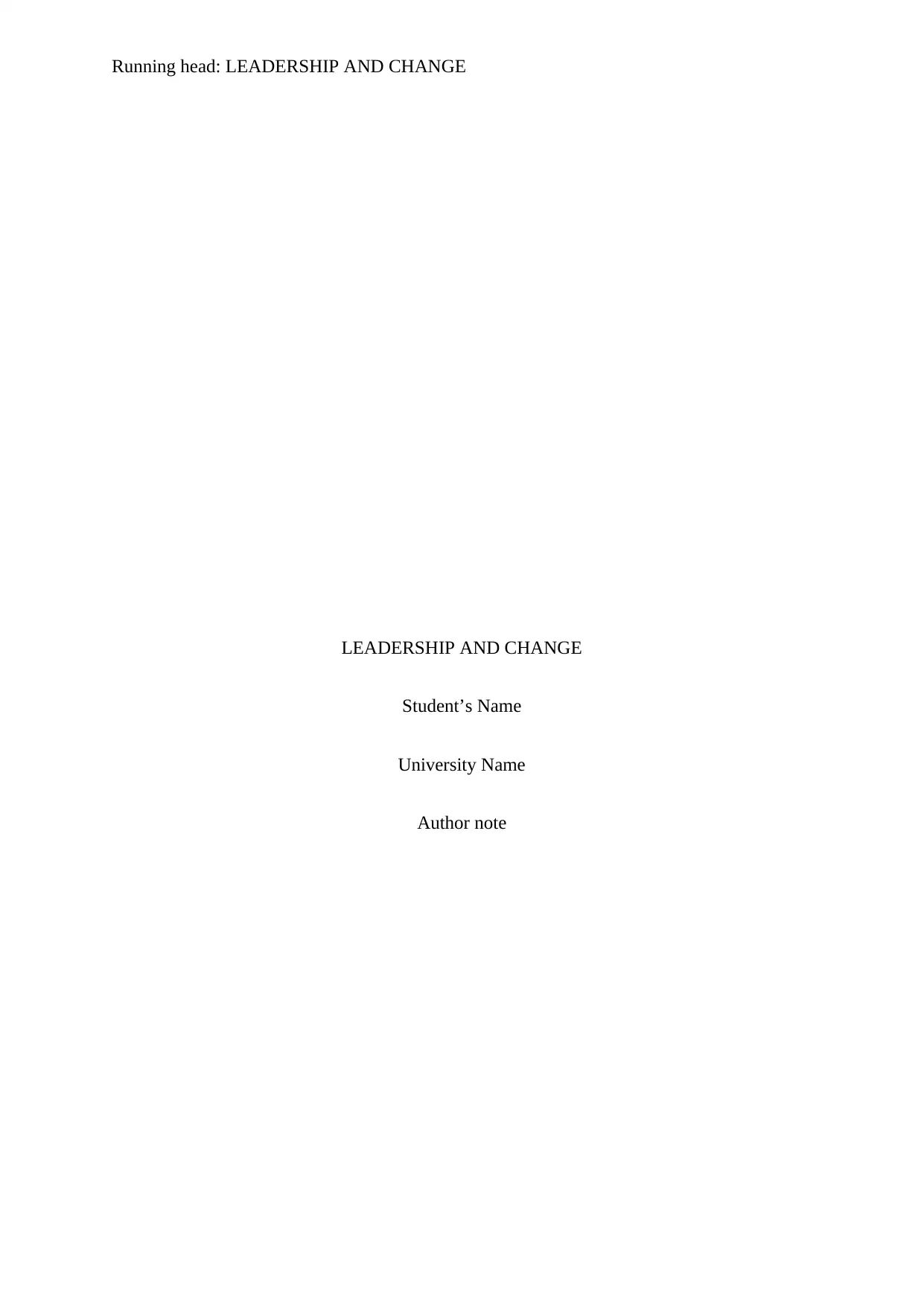
Running head: LEADERSHIP AND CHANGE
LEADERSHIP AND CHANGE
Student’s Name
University Name
Author note
LEADERSHIP AND CHANGE
Student’s Name
University Name
Author note
Paraphrase This Document
Need a fresh take? Get an instant paraphrase of this document with our AI Paraphraser
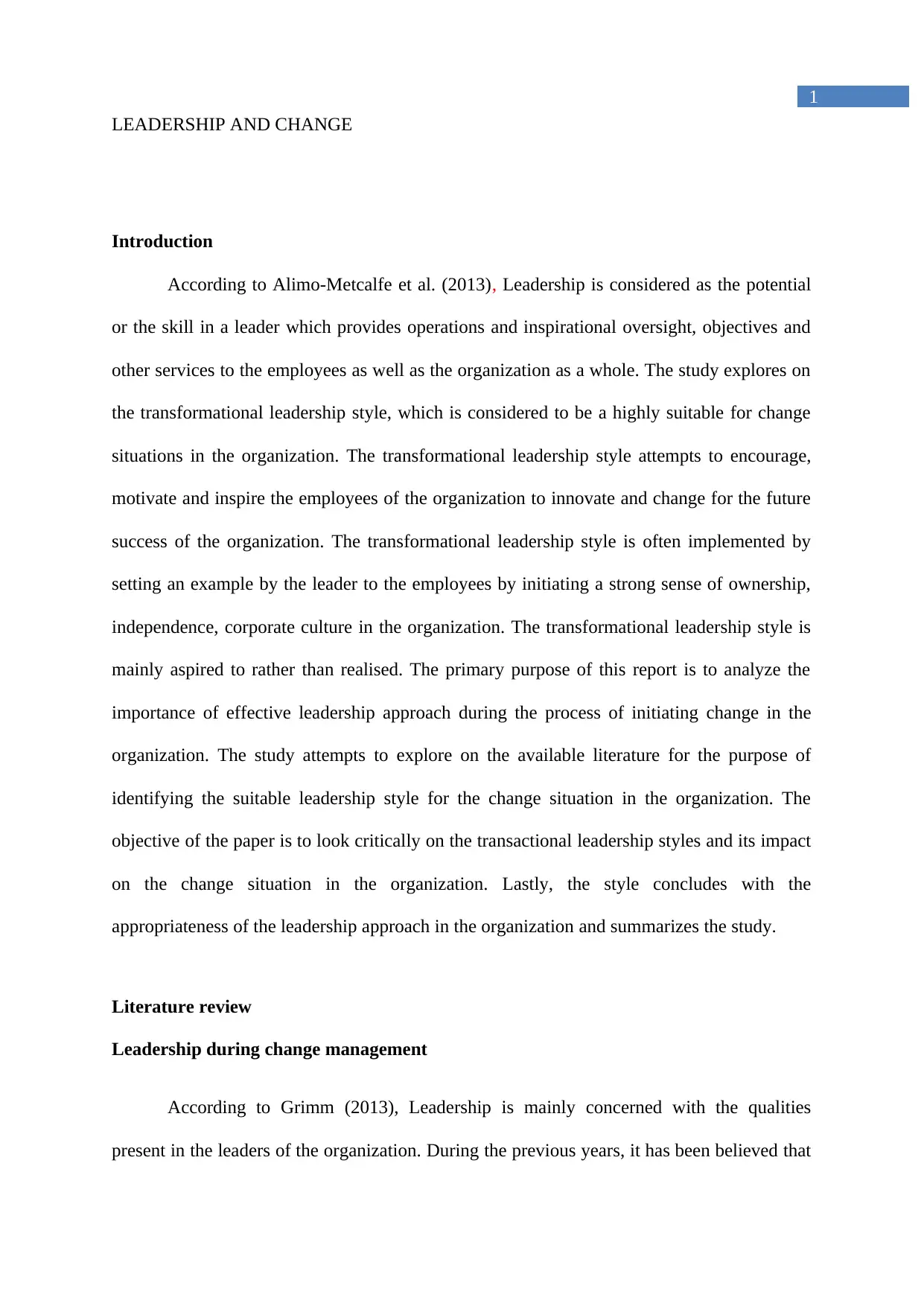
1
LEADERSHIP AND CHANGE
Introduction
According to Alimo-Metcalfe et al. (2013), Leadership is considered as the potential
or the skill in a leader which provides operations and inspirational oversight, objectives and
other services to the employees as well as the organization as a whole. The study explores on
the transformational leadership style, which is considered to be a highly suitable for change
situations in the organization. The transformational leadership style attempts to encourage,
motivate and inspire the employees of the organization to innovate and change for the future
success of the organization. The transformational leadership style is often implemented by
setting an example by the leader to the employees by initiating a strong sense of ownership,
independence, corporate culture in the organization. The transformational leadership style is
mainly aspired to rather than realised. The primary purpose of this report is to analyze the
importance of effective leadership approach during the process of initiating change in the
organization. The study attempts to explore on the available literature for the purpose of
identifying the suitable leadership style for the change situation in the organization. The
objective of the paper is to look critically on the transactional leadership styles and its impact
on the change situation in the organization. Lastly, the style concludes with the
appropriateness of the leadership approach in the organization and summarizes the study.
Literature review
Leadership during change management
According to Grimm (2013), Leadership is mainly concerned with the qualities
present in the leaders of the organization. During the previous years, it has been believed that
LEADERSHIP AND CHANGE
Introduction
According to Alimo-Metcalfe et al. (2013), Leadership is considered as the potential
or the skill in a leader which provides operations and inspirational oversight, objectives and
other services to the employees as well as the organization as a whole. The study explores on
the transformational leadership style, which is considered to be a highly suitable for change
situations in the organization. The transformational leadership style attempts to encourage,
motivate and inspire the employees of the organization to innovate and change for the future
success of the organization. The transformational leadership style is often implemented by
setting an example by the leader to the employees by initiating a strong sense of ownership,
independence, corporate culture in the organization. The transformational leadership style is
mainly aspired to rather than realised. The primary purpose of this report is to analyze the
importance of effective leadership approach during the process of initiating change in the
organization. The study attempts to explore on the available literature for the purpose of
identifying the suitable leadership style for the change situation in the organization. The
objective of the paper is to look critically on the transactional leadership styles and its impact
on the change situation in the organization. Lastly, the style concludes with the
appropriateness of the leadership approach in the organization and summarizes the study.
Literature review
Leadership during change management
According to Grimm (2013), Leadership is mainly concerned with the qualities
present in the leaders of the organization. During the previous years, it has been believed that
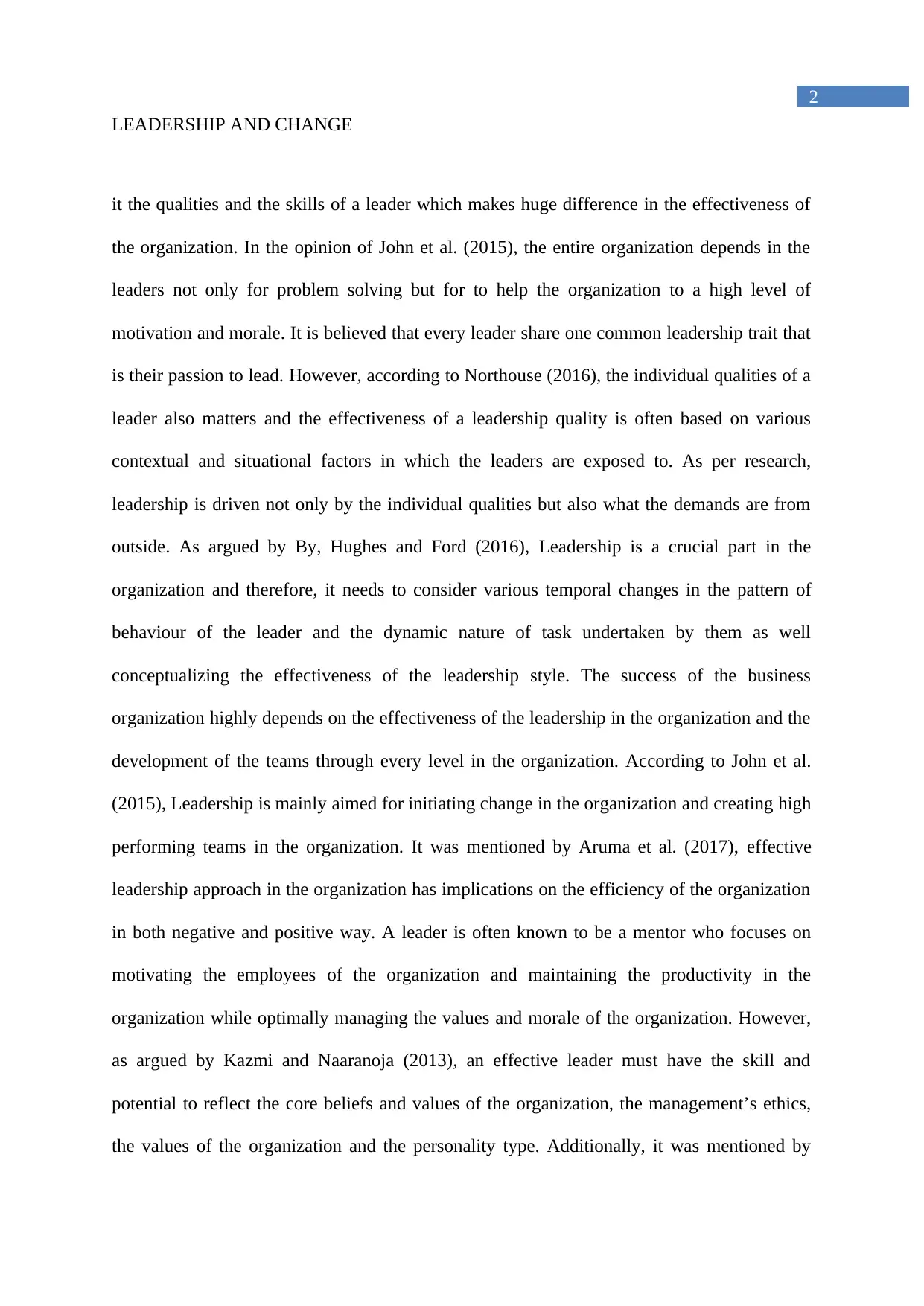
2
LEADERSHIP AND CHANGE
it the qualities and the skills of a leader which makes huge difference in the effectiveness of
the organization. In the opinion of John et al. (2015), the entire organization depends in the
leaders not only for problem solving but for to help the organization to a high level of
motivation and morale. It is believed that every leader share one common leadership trait that
is their passion to lead. However, according to Northouse (2016), the individual qualities of a
leader also matters and the effectiveness of a leadership quality is often based on various
contextual and situational factors in which the leaders are exposed to. As per research,
leadership is driven not only by the individual qualities but also what the demands are from
outside. As argued by By, Hughes and Ford (2016), Leadership is a crucial part in the
organization and therefore, it needs to consider various temporal changes in the pattern of
behaviour of the leader and the dynamic nature of task undertaken by them as well
conceptualizing the effectiveness of the leadership style. The success of the business
organization highly depends on the effectiveness of the leadership in the organization and the
development of the teams through every level in the organization. According to John et al.
(2015), Leadership is mainly aimed for initiating change in the organization and creating high
performing teams in the organization. It was mentioned by Aruma et al. (2017), effective
leadership approach in the organization has implications on the efficiency of the organization
in both negative and positive way. A leader is often known to be a mentor who focuses on
motivating the employees of the organization and maintaining the productivity in the
organization while optimally managing the values and morale of the organization. However,
as argued by Kazmi and Naaranoja (2013), an effective leader must have the skill and
potential to reflect the core beliefs and values of the organization, the management’s ethics,
the values of the organization and the personality type. Additionally, it was mentioned by
LEADERSHIP AND CHANGE
it the qualities and the skills of a leader which makes huge difference in the effectiveness of
the organization. In the opinion of John et al. (2015), the entire organization depends in the
leaders not only for problem solving but for to help the organization to a high level of
motivation and morale. It is believed that every leader share one common leadership trait that
is their passion to lead. However, according to Northouse (2016), the individual qualities of a
leader also matters and the effectiveness of a leadership quality is often based on various
contextual and situational factors in which the leaders are exposed to. As per research,
leadership is driven not only by the individual qualities but also what the demands are from
outside. As argued by By, Hughes and Ford (2016), Leadership is a crucial part in the
organization and therefore, it needs to consider various temporal changes in the pattern of
behaviour of the leader and the dynamic nature of task undertaken by them as well
conceptualizing the effectiveness of the leadership style. The success of the business
organization highly depends on the effectiveness of the leadership in the organization and the
development of the teams through every level in the organization. According to John et al.
(2015), Leadership is mainly aimed for initiating change in the organization and creating high
performing teams in the organization. It was mentioned by Aruma et al. (2017), effective
leadership approach in the organization has implications on the efficiency of the organization
in both negative and positive way. A leader is often known to be a mentor who focuses on
motivating the employees of the organization and maintaining the productivity in the
organization while optimally managing the values and morale of the organization. However,
as argued by Kazmi and Naaranoja (2013), an effective leader must have the skill and
potential to reflect the core beliefs and values of the organization, the management’s ethics,
the values of the organization and the personality type. Additionally, it was mentioned by
⊘ This is a preview!⊘
Do you want full access?
Subscribe today to unlock all pages.

Trusted by 1+ million students worldwide
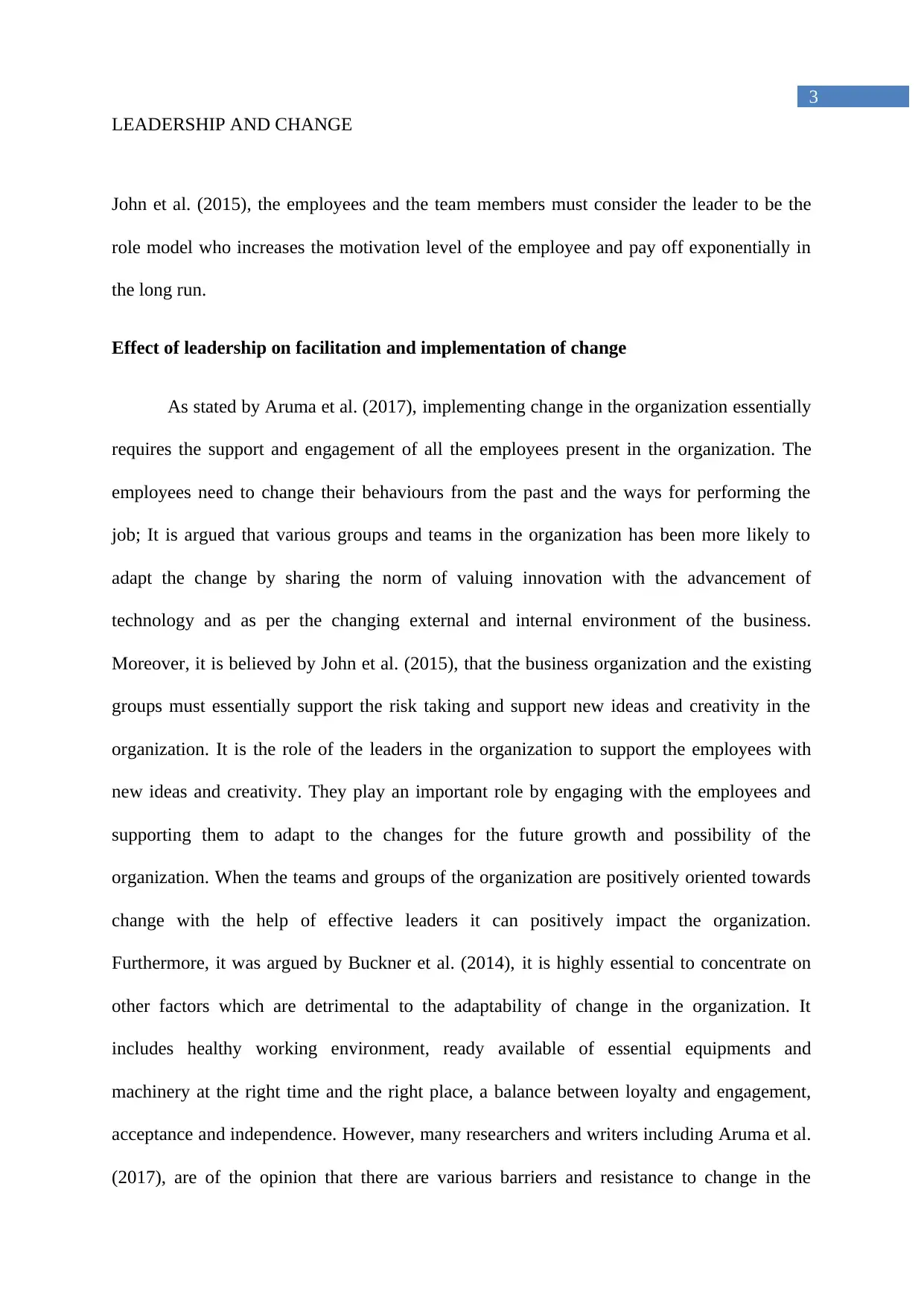
3
LEADERSHIP AND CHANGE
John et al. (2015), the employees and the team members must consider the leader to be the
role model who increases the motivation level of the employee and pay off exponentially in
the long run.
Effect of leadership on facilitation and implementation of change
As stated by Aruma et al. (2017), implementing change in the organization essentially
requires the support and engagement of all the employees present in the organization. The
employees need to change their behaviours from the past and the ways for performing the
job; It is argued that various groups and teams in the organization has been more likely to
adapt the change by sharing the norm of valuing innovation with the advancement of
technology and as per the changing external and internal environment of the business.
Moreover, it is believed by John et al. (2015), that the business organization and the existing
groups must essentially support the risk taking and support new ideas and creativity in the
organization. It is the role of the leaders in the organization to support the employees with
new ideas and creativity. They play an important role by engaging with the employees and
supporting them to adapt to the changes for the future growth and possibility of the
organization. When the teams and groups of the organization are positively oriented towards
change with the help of effective leaders it can positively impact the organization.
Furthermore, it was argued by Buckner et al. (2014), it is highly essential to concentrate on
other factors which are detrimental to the adaptability of change in the organization. It
includes healthy working environment, ready available of essential equipments and
machinery at the right time and the right place, a balance between loyalty and engagement,
acceptance and independence. However, many researchers and writers including Aruma et al.
(2017), are of the opinion that there are various barriers and resistance to change in the
LEADERSHIP AND CHANGE
John et al. (2015), the employees and the team members must consider the leader to be the
role model who increases the motivation level of the employee and pay off exponentially in
the long run.
Effect of leadership on facilitation and implementation of change
As stated by Aruma et al. (2017), implementing change in the organization essentially
requires the support and engagement of all the employees present in the organization. The
employees need to change their behaviours from the past and the ways for performing the
job; It is argued that various groups and teams in the organization has been more likely to
adapt the change by sharing the norm of valuing innovation with the advancement of
technology and as per the changing external and internal environment of the business.
Moreover, it is believed by John et al. (2015), that the business organization and the existing
groups must essentially support the risk taking and support new ideas and creativity in the
organization. It is the role of the leaders in the organization to support the employees with
new ideas and creativity. They play an important role by engaging with the employees and
supporting them to adapt to the changes for the future growth and possibility of the
organization. When the teams and groups of the organization are positively oriented towards
change with the help of effective leaders it can positively impact the organization.
Furthermore, it was argued by Buckner et al. (2014), it is highly essential to concentrate on
other factors which are detrimental to the adaptability of change in the organization. It
includes healthy working environment, ready available of essential equipments and
machinery at the right time and the right place, a balance between loyalty and engagement,
acceptance and independence. However, many researchers and writers including Aruma et al.
(2017), are of the opinion that there are various barriers and resistance to change in the
Paraphrase This Document
Need a fresh take? Get an instant paraphrase of this document with our AI Paraphraser
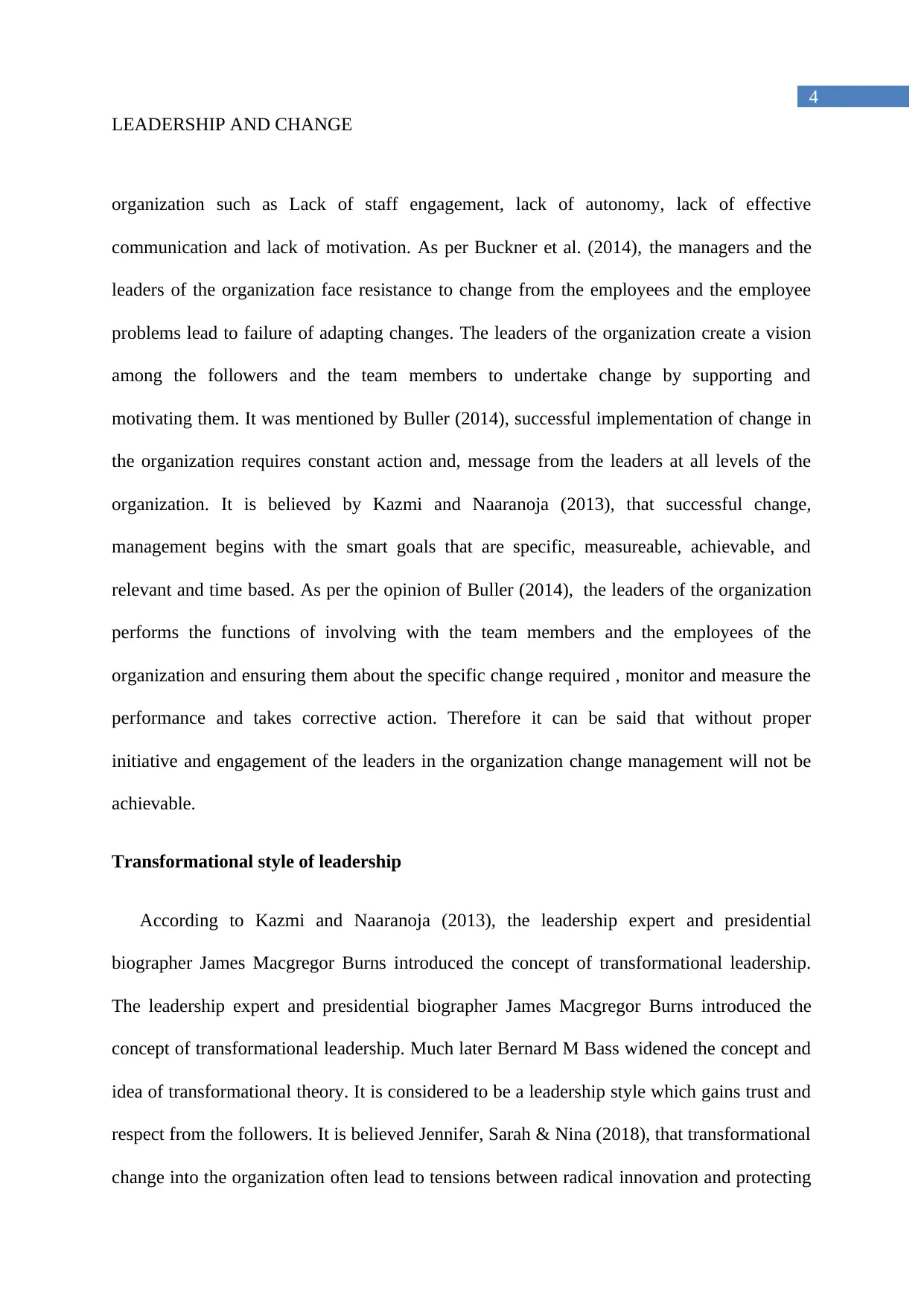
4
LEADERSHIP AND CHANGE
organization such as Lack of staff engagement, lack of autonomy, lack of effective
communication and lack of motivation. As per Buckner et al. (2014), the managers and the
leaders of the organization face resistance to change from the employees and the employee
problems lead to failure of adapting changes. The leaders of the organization create a vision
among the followers and the team members to undertake change by supporting and
motivating them. It was mentioned by Buller (2014), successful implementation of change in
the organization requires constant action and, message from the leaders at all levels of the
organization. It is believed by Kazmi and Naaranoja (2013), that successful change,
management begins with the smart goals that are specific, measureable, achievable, and
relevant and time based. As per the opinion of Buller (2014), the leaders of the organization
performs the functions of involving with the team members and the employees of the
organization and ensuring them about the specific change required , monitor and measure the
performance and takes corrective action. Therefore it can be said that without proper
initiative and engagement of the leaders in the organization change management will not be
achievable.
Transformational style of leadership
According to Kazmi and Naaranoja (2013), the leadership expert and presidential
biographer James Macgregor Burns introduced the concept of transformational leadership.
The leadership expert and presidential biographer James Macgregor Burns introduced the
concept of transformational leadership. Much later Bernard M Bass widened the concept and
idea of transformational theory. It is considered to be a leadership style which gains trust and
respect from the followers. It is believed Jennifer, Sarah & Nina (2018), that transformational
change into the organization often lead to tensions between radical innovation and protecting
LEADERSHIP AND CHANGE
organization such as Lack of staff engagement, lack of autonomy, lack of effective
communication and lack of motivation. As per Buckner et al. (2014), the managers and the
leaders of the organization face resistance to change from the employees and the employee
problems lead to failure of adapting changes. The leaders of the organization create a vision
among the followers and the team members to undertake change by supporting and
motivating them. It was mentioned by Buller (2014), successful implementation of change in
the organization requires constant action and, message from the leaders at all levels of the
organization. It is believed by Kazmi and Naaranoja (2013), that successful change,
management begins with the smart goals that are specific, measureable, achievable, and
relevant and time based. As per the opinion of Buller (2014), the leaders of the organization
performs the functions of involving with the team members and the employees of the
organization and ensuring them about the specific change required , monitor and measure the
performance and takes corrective action. Therefore it can be said that without proper
initiative and engagement of the leaders in the organization change management will not be
achievable.
Transformational style of leadership
According to Kazmi and Naaranoja (2013), the leadership expert and presidential
biographer James Macgregor Burns introduced the concept of transformational leadership.
The leadership expert and presidential biographer James Macgregor Burns introduced the
concept of transformational leadership. Much later Bernard M Bass widened the concept and
idea of transformational theory. It is considered to be a leadership style which gains trust and
respect from the followers. It is believed Jennifer, Sarah & Nina (2018), that transformational
change into the organization often lead to tensions between radical innovation and protecting
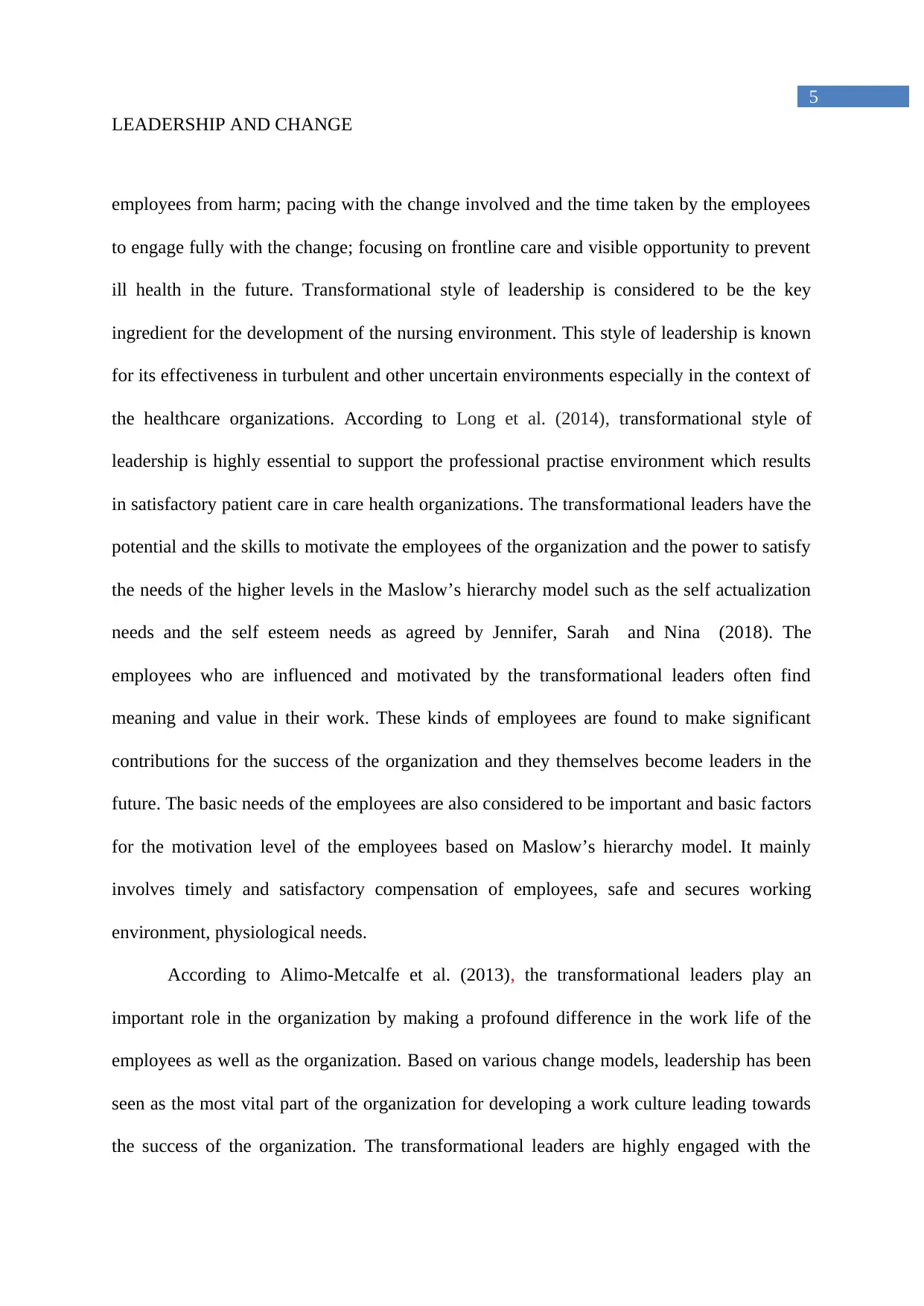
5
LEADERSHIP AND CHANGE
employees from harm; pacing with the change involved and the time taken by the employees
to engage fully with the change; focusing on frontline care and visible opportunity to prevent
ill health in the future. Transformational style of leadership is considered to be the key
ingredient for the development of the nursing environment. This style of leadership is known
for its effectiveness in turbulent and other uncertain environments especially in the context of
the healthcare organizations. According to Long et al. (2014), transformational style of
leadership is highly essential to support the professional practise environment which results
in satisfactory patient care in care health organizations. The transformational leaders have the
potential and the skills to motivate the employees of the organization and the power to satisfy
the needs of the higher levels in the Maslow’s hierarchy model such as the self actualization
needs and the self esteem needs as agreed by Jennifer, Sarah and Nina (2018). The
employees who are influenced and motivated by the transformational leaders often find
meaning and value in their work. These kinds of employees are found to make significant
contributions for the success of the organization and they themselves become leaders in the
future. The basic needs of the employees are also considered to be important and basic factors
for the motivation level of the employees based on Maslow’s hierarchy model. It mainly
involves timely and satisfactory compensation of employees, safe and secures working
environment, physiological needs.
According to Alimo-Metcalfe et al. (2013), the transformational leaders play an
important role in the organization by making a profound difference in the work life of the
employees as well as the organization. Based on various change models, leadership has been
seen as the most vital part of the organization for developing a work culture leading towards
the success of the organization. The transformational leaders are highly engaged with the
LEADERSHIP AND CHANGE
employees from harm; pacing with the change involved and the time taken by the employees
to engage fully with the change; focusing on frontline care and visible opportunity to prevent
ill health in the future. Transformational style of leadership is considered to be the key
ingredient for the development of the nursing environment. This style of leadership is known
for its effectiveness in turbulent and other uncertain environments especially in the context of
the healthcare organizations. According to Long et al. (2014), transformational style of
leadership is highly essential to support the professional practise environment which results
in satisfactory patient care in care health organizations. The transformational leaders have the
potential and the skills to motivate the employees of the organization and the power to satisfy
the needs of the higher levels in the Maslow’s hierarchy model such as the self actualization
needs and the self esteem needs as agreed by Jennifer, Sarah and Nina (2018). The
employees who are influenced and motivated by the transformational leaders often find
meaning and value in their work. These kinds of employees are found to make significant
contributions for the success of the organization and they themselves become leaders in the
future. The basic needs of the employees are also considered to be important and basic factors
for the motivation level of the employees based on Maslow’s hierarchy model. It mainly
involves timely and satisfactory compensation of employees, safe and secures working
environment, physiological needs.
According to Alimo-Metcalfe et al. (2013), the transformational leaders play an
important role in the organization by making a profound difference in the work life of the
employees as well as the organization. Based on various change models, leadership has been
seen as the most vital part of the organization for developing a work culture leading towards
the success of the organization. The transformational leaders are highly engaged with the
⊘ This is a preview!⊘
Do you want full access?
Subscribe today to unlock all pages.

Trusted by 1+ million students worldwide
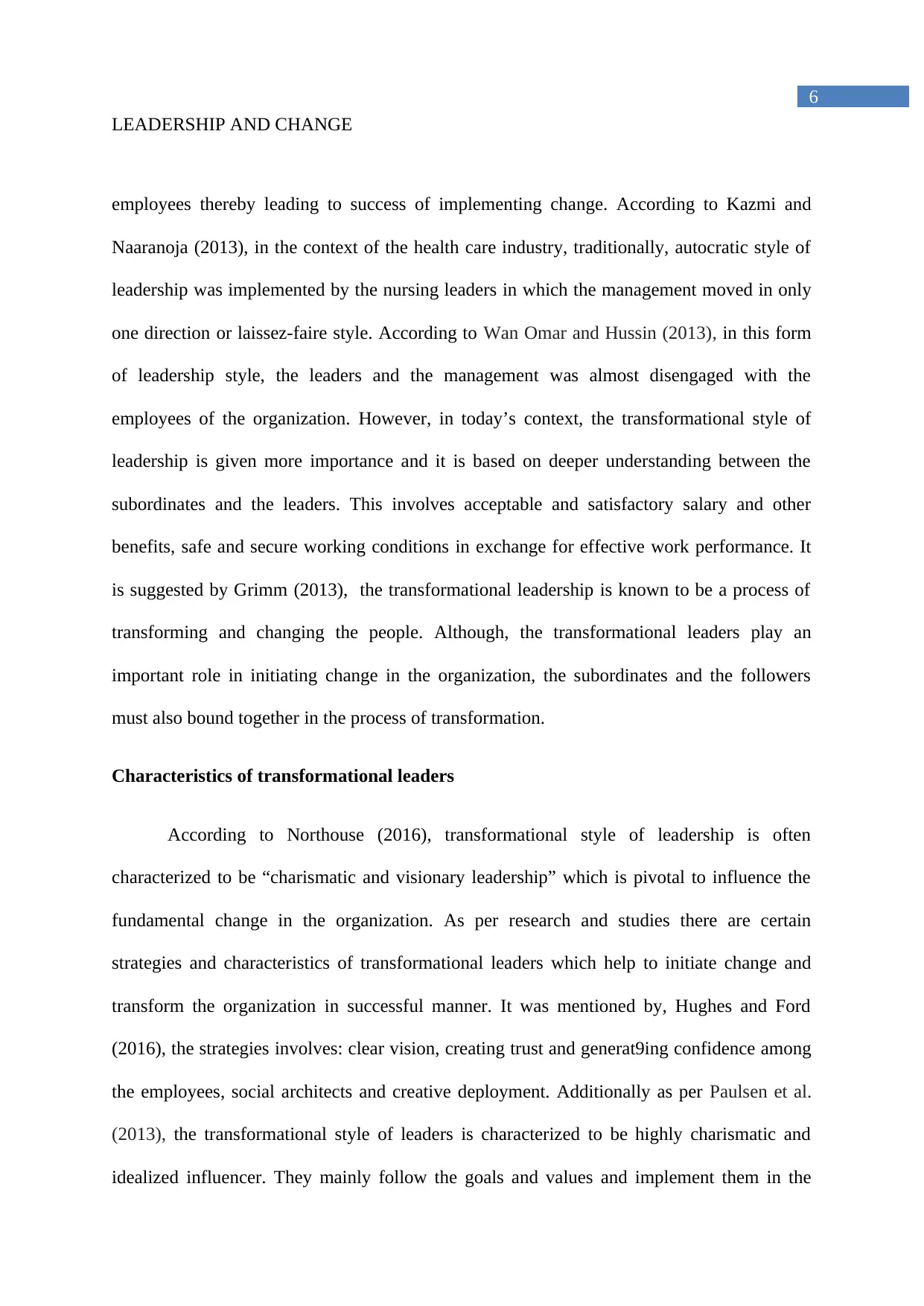
6
LEADERSHIP AND CHANGE
employees thereby leading to success of implementing change. According to Kazmi and
Naaranoja (2013), in the context of the health care industry, traditionally, autocratic style of
leadership was implemented by the nursing leaders in which the management moved in only
one direction or laissez-faire style. According to Wan Omar and Hussin (2013), in this form
of leadership style, the leaders and the management was almost disengaged with the
employees of the organization. However, in today’s context, the transformational style of
leadership is given more importance and it is based on deeper understanding between the
subordinates and the leaders. This involves acceptable and satisfactory salary and other
benefits, safe and secure working conditions in exchange for effective work performance. It
is suggested by Grimm (2013), the transformational leadership is known to be a process of
transforming and changing the people. Although, the transformational leaders play an
important role in initiating change in the organization, the subordinates and the followers
must also bound together in the process of transformation.
Characteristics of transformational leaders
According to Northouse (2016), transformational style of leadership is often
characterized to be “charismatic and visionary leadership” which is pivotal to influence the
fundamental change in the organization. As per research and studies there are certain
strategies and characteristics of transformational leaders which help to initiate change and
transform the organization in successful manner. It was mentioned by, Hughes and Ford
(2016), the strategies involves: clear vision, creating trust and generat9ing confidence among
the employees, social architects and creative deployment. Additionally as per Paulsen et al.
(2013), the transformational style of leaders is characterized to be highly charismatic and
idealized influencer. They mainly follow the goals and values and implement them in the
LEADERSHIP AND CHANGE
employees thereby leading to success of implementing change. According to Kazmi and
Naaranoja (2013), in the context of the health care industry, traditionally, autocratic style of
leadership was implemented by the nursing leaders in which the management moved in only
one direction or laissez-faire style. According to Wan Omar and Hussin (2013), in this form
of leadership style, the leaders and the management was almost disengaged with the
employees of the organization. However, in today’s context, the transformational style of
leadership is given more importance and it is based on deeper understanding between the
subordinates and the leaders. This involves acceptable and satisfactory salary and other
benefits, safe and secure working conditions in exchange for effective work performance. It
is suggested by Grimm (2013), the transformational leadership is known to be a process of
transforming and changing the people. Although, the transformational leaders play an
important role in initiating change in the organization, the subordinates and the followers
must also bound together in the process of transformation.
Characteristics of transformational leaders
According to Northouse (2016), transformational style of leadership is often
characterized to be “charismatic and visionary leadership” which is pivotal to influence the
fundamental change in the organization. As per research and studies there are certain
strategies and characteristics of transformational leaders which help to initiate change and
transform the organization in successful manner. It was mentioned by, Hughes and Ford
(2016), the strategies involves: clear vision, creating trust and generat9ing confidence among
the employees, social architects and creative deployment. Additionally as per Paulsen et al.
(2013), the transformational style of leaders is characterized to be highly charismatic and
idealized influencer. They mainly follow the goals and values and implement them in the
Paraphrase This Document
Need a fresh take? Get an instant paraphrase of this document with our AI Paraphraser
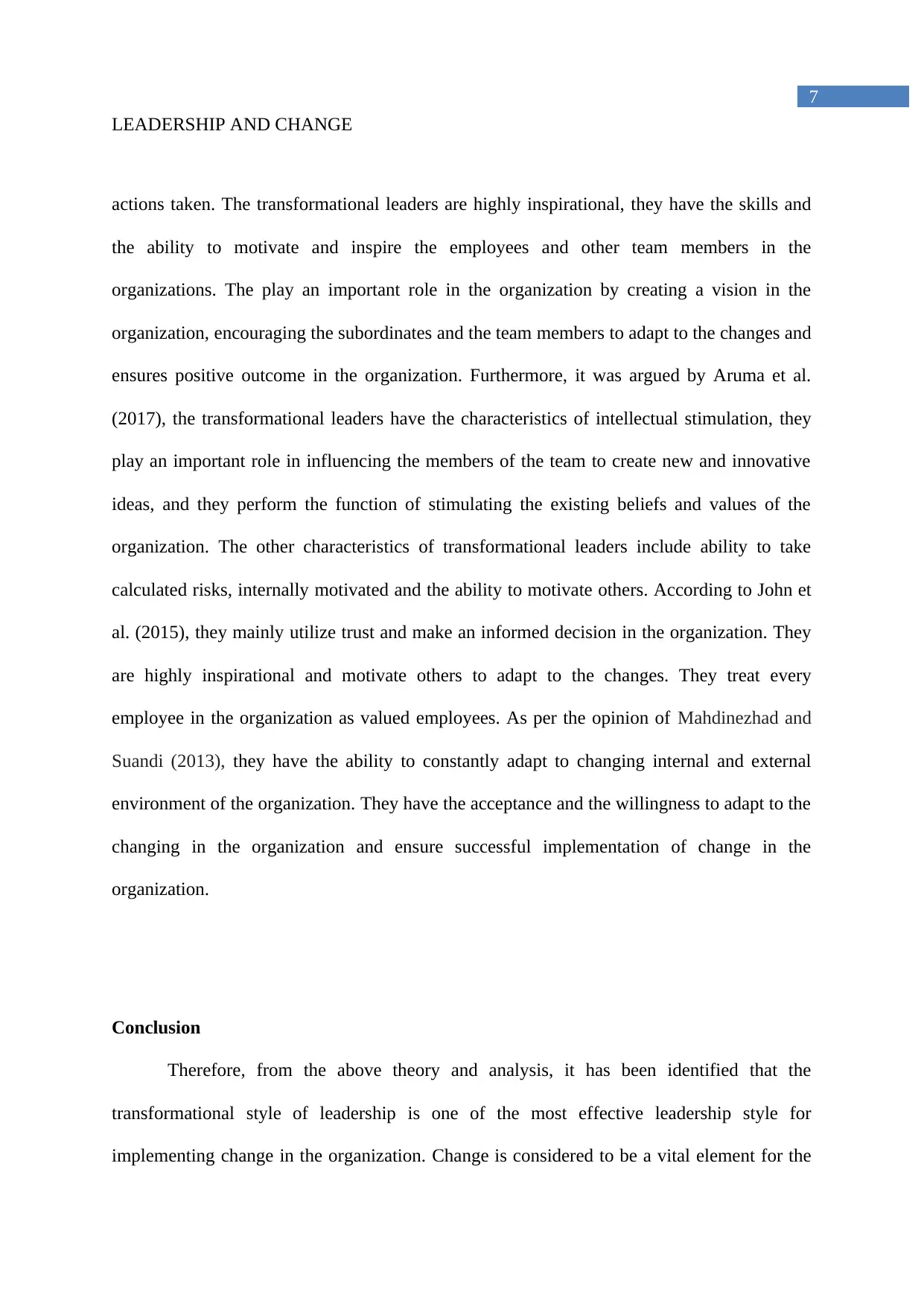
7
LEADERSHIP AND CHANGE
actions taken. The transformational leaders are highly inspirational, they have the skills and
the ability to motivate and inspire the employees and other team members in the
organizations. The play an important role in the organization by creating a vision in the
organization, encouraging the subordinates and the team members to adapt to the changes and
ensures positive outcome in the organization. Furthermore, it was argued by Aruma et al.
(2017), the transformational leaders have the characteristics of intellectual stimulation, they
play an important role in influencing the members of the team to create new and innovative
ideas, and they perform the function of stimulating the existing beliefs and values of the
organization. The other characteristics of transformational leaders include ability to take
calculated risks, internally motivated and the ability to motivate others. According to John et
al. (2015), they mainly utilize trust and make an informed decision in the organization. They
are highly inspirational and motivate others to adapt to the changes. They treat every
employee in the organization as valued employees. As per the opinion of Mahdinezhad and
Suandi (2013), they have the ability to constantly adapt to changing internal and external
environment of the organization. They have the acceptance and the willingness to adapt to the
changing in the organization and ensure successful implementation of change in the
organization.
Conclusion
Therefore, from the above theory and analysis, it has been identified that the
transformational style of leadership is one of the most effective leadership style for
implementing change in the organization. Change is considered to be a vital element for the
LEADERSHIP AND CHANGE
actions taken. The transformational leaders are highly inspirational, they have the skills and
the ability to motivate and inspire the employees and other team members in the
organizations. The play an important role in the organization by creating a vision in the
organization, encouraging the subordinates and the team members to adapt to the changes and
ensures positive outcome in the organization. Furthermore, it was argued by Aruma et al.
(2017), the transformational leaders have the characteristics of intellectual stimulation, they
play an important role in influencing the members of the team to create new and innovative
ideas, and they perform the function of stimulating the existing beliefs and values of the
organization. The other characteristics of transformational leaders include ability to take
calculated risks, internally motivated and the ability to motivate others. According to John et
al. (2015), they mainly utilize trust and make an informed decision in the organization. They
are highly inspirational and motivate others to adapt to the changes. They treat every
employee in the organization as valued employees. As per the opinion of Mahdinezhad and
Suandi (2013), they have the ability to constantly adapt to changing internal and external
environment of the organization. They have the acceptance and the willingness to adapt to the
changing in the organization and ensure successful implementation of change in the
organization.
Conclusion
Therefore, from the above theory and analysis, it has been identified that the
transformational style of leadership is one of the most effective leadership style for
implementing change in the organization. Change is considered to be a vital element for the
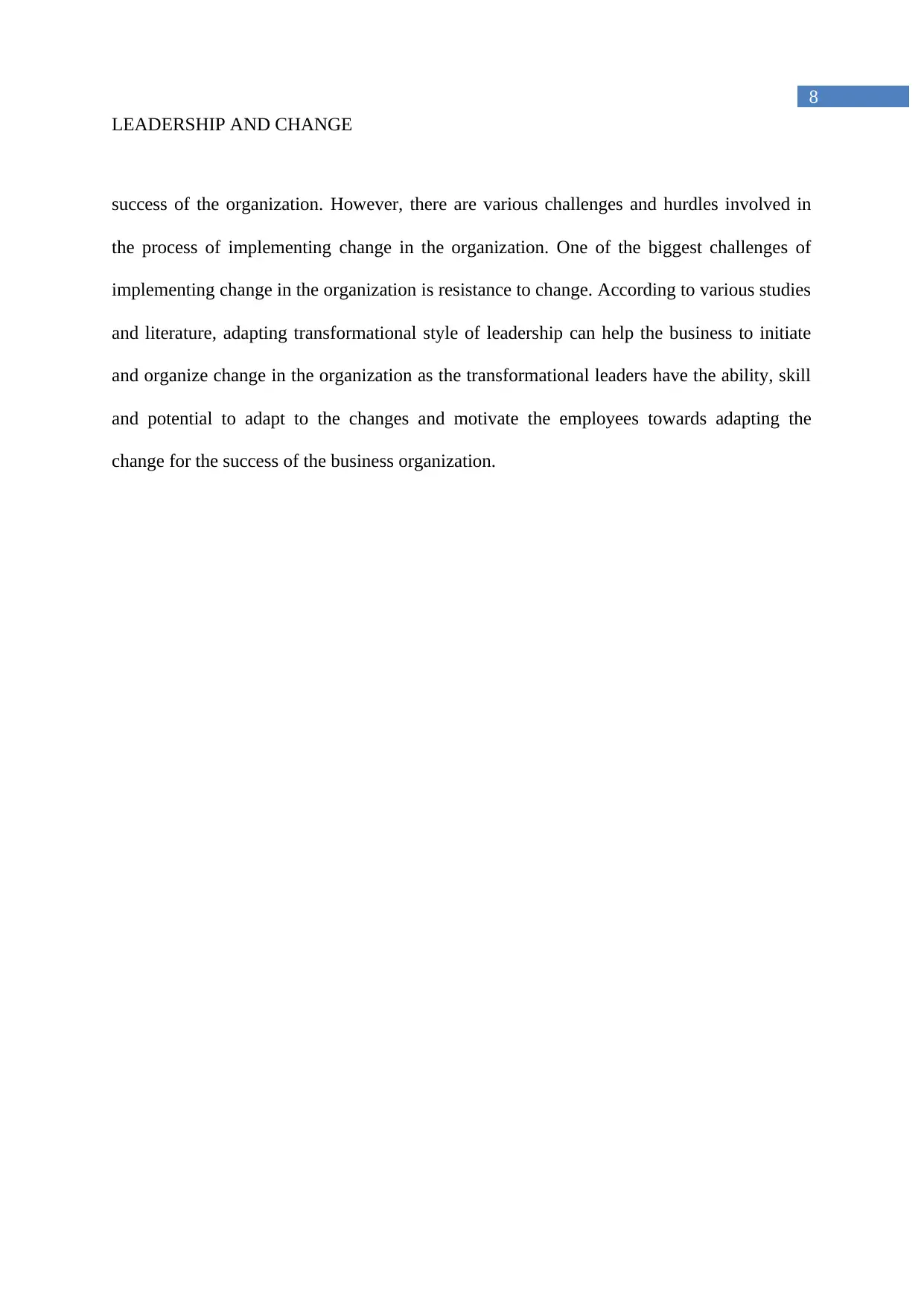
8
LEADERSHIP AND CHANGE
success of the organization. However, there are various challenges and hurdles involved in
the process of implementing change in the organization. One of the biggest challenges of
implementing change in the organization is resistance to change. According to various studies
and literature, adapting transformational style of leadership can help the business to initiate
and organize change in the organization as the transformational leaders have the ability, skill
and potential to adapt to the changes and motivate the employees towards adapting the
change for the success of the business organization.
LEADERSHIP AND CHANGE
success of the organization. However, there are various challenges and hurdles involved in
the process of implementing change in the organization. One of the biggest challenges of
implementing change in the organization is resistance to change. According to various studies
and literature, adapting transformational style of leadership can help the business to initiate
and organize change in the organization as the transformational leaders have the ability, skill
and potential to adapt to the changes and motivate the employees towards adapting the
change for the success of the business organization.
⊘ This is a preview!⊘
Do you want full access?
Subscribe today to unlock all pages.

Trusted by 1+ million students worldwide
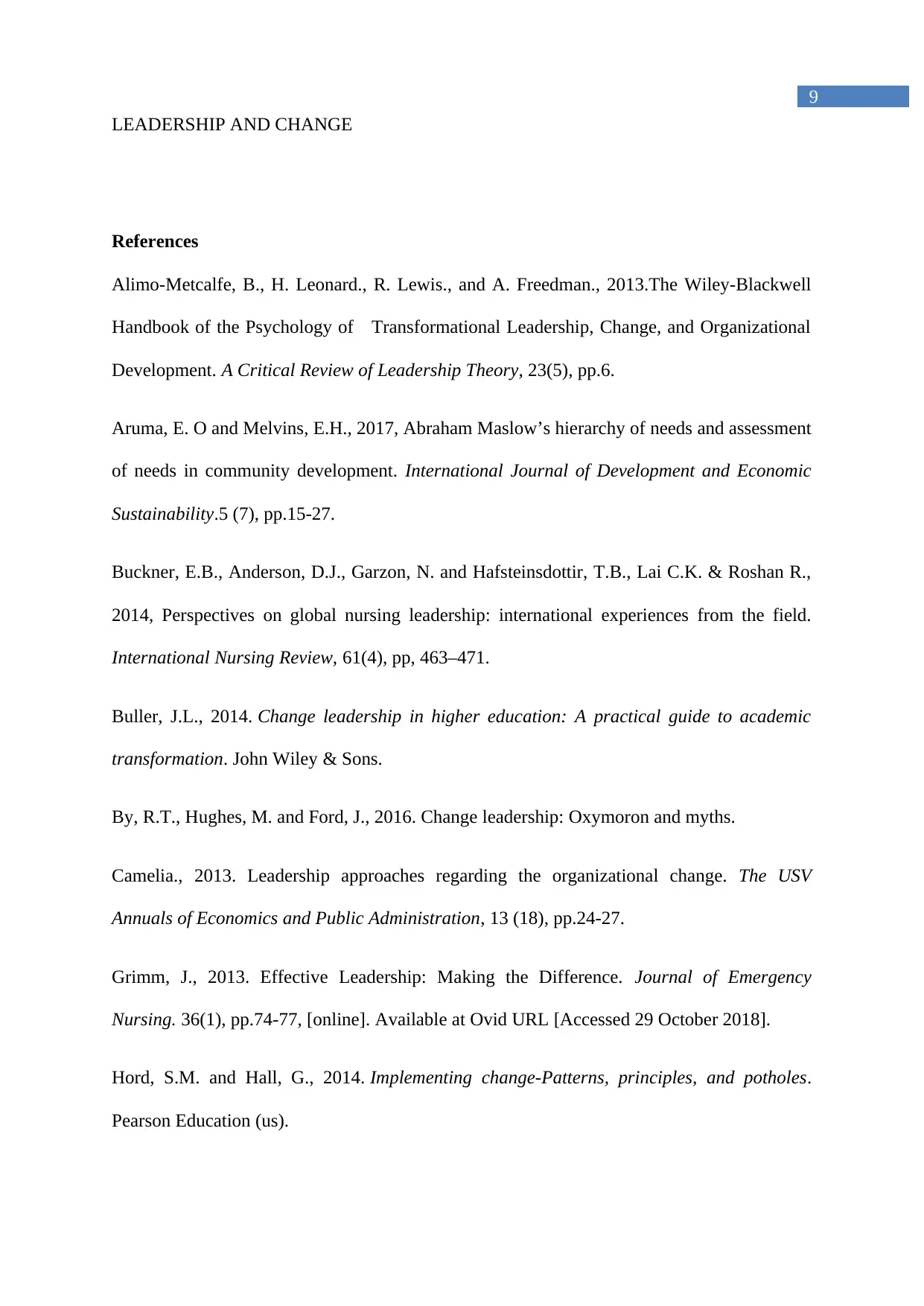
9
LEADERSHIP AND CHANGE
References
Alimo-Metcalfe, B., H. Leonard., R. Lewis., and A. Freedman., 2013.The Wiley-Blackwell
Handbook of the Psychology of Transformational Leadership, Change, and Organizational
Development. A Critical Review of Leadership Theory, 23(5), pp.6.
Aruma, E. O and Melvins, E.H., 2017, Abraham Maslow’s hierarchy of needs and assessment
of needs in community development. International Journal of Development and Economic
Sustainability.5 (7), pp.15-27.
Buckner, E.B., Anderson, D.J., Garzon, N. and Hafsteinsdottir, T.B., Lai C.K. & Roshan R.,
2014, Perspectives on global nursing leadership: international experiences from the field.
International Nursing Review, 61(4), pp, 463–471.
Buller, J.L., 2014. Change leadership in higher education: A practical guide to academic
transformation. John Wiley & Sons.
By, R.T., Hughes, M. and Ford, J., 2016. Change leadership: Oxymoron and myths.
Camelia., 2013. Leadership approaches regarding the organizational change. The USV
Annuals of Economics and Public Administration, 13 (18), pp.24-27.
Grimm, J., 2013. Effective Leadership: Making the Difference. Journal of Emergency
Nursing. 36(1), pp.74-77, [online]. Available at Ovid URL [Accessed 29 October 2018].
Hord, S.M. and Hall, G., 2014. Implementing change-Patterns, principles, and potholes.
Pearson Education (us).
LEADERSHIP AND CHANGE
References
Alimo-Metcalfe, B., H. Leonard., R. Lewis., and A. Freedman., 2013.The Wiley-Blackwell
Handbook of the Psychology of Transformational Leadership, Change, and Organizational
Development. A Critical Review of Leadership Theory, 23(5), pp.6.
Aruma, E. O and Melvins, E.H., 2017, Abraham Maslow’s hierarchy of needs and assessment
of needs in community development. International Journal of Development and Economic
Sustainability.5 (7), pp.15-27.
Buckner, E.B., Anderson, D.J., Garzon, N. and Hafsteinsdottir, T.B., Lai C.K. & Roshan R.,
2014, Perspectives on global nursing leadership: international experiences from the field.
International Nursing Review, 61(4), pp, 463–471.
Buller, J.L., 2014. Change leadership in higher education: A practical guide to academic
transformation. John Wiley & Sons.
By, R.T., Hughes, M. and Ford, J., 2016. Change leadership: Oxymoron and myths.
Camelia., 2013. Leadership approaches regarding the organizational change. The USV
Annuals of Economics and Public Administration, 13 (18), pp.24-27.
Grimm, J., 2013. Effective Leadership: Making the Difference. Journal of Emergency
Nursing. 36(1), pp.74-77, [online]. Available at Ovid URL [Accessed 29 October 2018].
Hord, S.M. and Hall, G., 2014. Implementing change-Patterns, principles, and potholes.
Pearson Education (us).
Paraphrase This Document
Need a fresh take? Get an instant paraphrase of this document with our AI Paraphraser
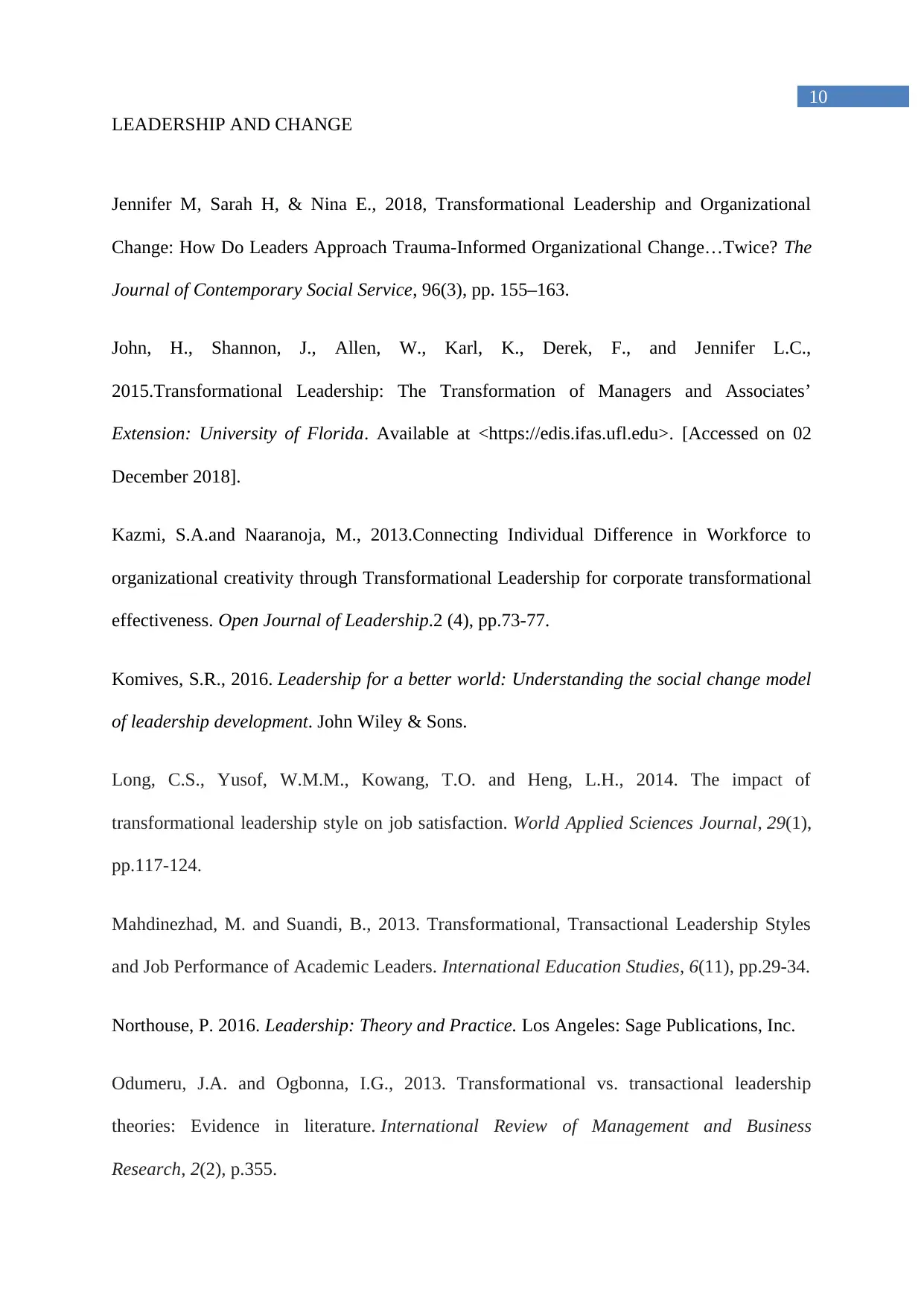
10
LEADERSHIP AND CHANGE
Jennifer M, Sarah H, & Nina E., 2018, Transformational Leadership and Organizational
Change: How Do Leaders Approach Trauma-Informed Organizational Change…Twice? The
Journal of Contemporary Social Service, 96(3), pp. 155–163.
John, H., Shannon, J., Allen, W., Karl, K., Derek, F., and Jennifer L.C.,
2015.Transformational Leadership: The Transformation of Managers and Associates’
Extension: University of Florida. Available at <https://edis.ifas.ufl.edu>. [Accessed on 02
December 2018].
Kazmi, S.A.and Naaranoja, M., 2013.Connecting Individual Difference in Workforce to
organizational creativity through Transformational Leadership for corporate transformational
effectiveness. Open Journal of Leadership.2 (4), pp.73-77.
Komives, S.R., 2016. Leadership for a better world: Understanding the social change model
of leadership development. John Wiley & Sons.
Long, C.S., Yusof, W.M.M., Kowang, T.O. and Heng, L.H., 2014. The impact of
transformational leadership style on job satisfaction. World Applied Sciences Journal, 29(1),
pp.117-124.
Mahdinezhad, M. and Suandi, B., 2013. Transformational, Transactional Leadership Styles
and Job Performance of Academic Leaders. International Education Studies, 6(11), pp.29-34.
Northouse, P. 2016. Leadership: Theory and Practice. Los Angeles: Sage Publications, Inc.
Odumeru, J.A. and Ogbonna, I.G., 2013. Transformational vs. transactional leadership
theories: Evidence in literature. International Review of Management and Business
Research, 2(2), p.355.
LEADERSHIP AND CHANGE
Jennifer M, Sarah H, & Nina E., 2018, Transformational Leadership and Organizational
Change: How Do Leaders Approach Trauma-Informed Organizational Change…Twice? The
Journal of Contemporary Social Service, 96(3), pp. 155–163.
John, H., Shannon, J., Allen, W., Karl, K., Derek, F., and Jennifer L.C.,
2015.Transformational Leadership: The Transformation of Managers and Associates’
Extension: University of Florida. Available at <https://edis.ifas.ufl.edu>. [Accessed on 02
December 2018].
Kazmi, S.A.and Naaranoja, M., 2013.Connecting Individual Difference in Workforce to
organizational creativity through Transformational Leadership for corporate transformational
effectiveness. Open Journal of Leadership.2 (4), pp.73-77.
Komives, S.R., 2016. Leadership for a better world: Understanding the social change model
of leadership development. John Wiley & Sons.
Long, C.S., Yusof, W.M.M., Kowang, T.O. and Heng, L.H., 2014. The impact of
transformational leadership style on job satisfaction. World Applied Sciences Journal, 29(1),
pp.117-124.
Mahdinezhad, M. and Suandi, B., 2013. Transformational, Transactional Leadership Styles
and Job Performance of Academic Leaders. International Education Studies, 6(11), pp.29-34.
Northouse, P. 2016. Leadership: Theory and Practice. Los Angeles: Sage Publications, Inc.
Odumeru, J.A. and Ogbonna, I.G., 2013. Transformational vs. transactional leadership
theories: Evidence in literature. International Review of Management and Business
Research, 2(2), p.355.
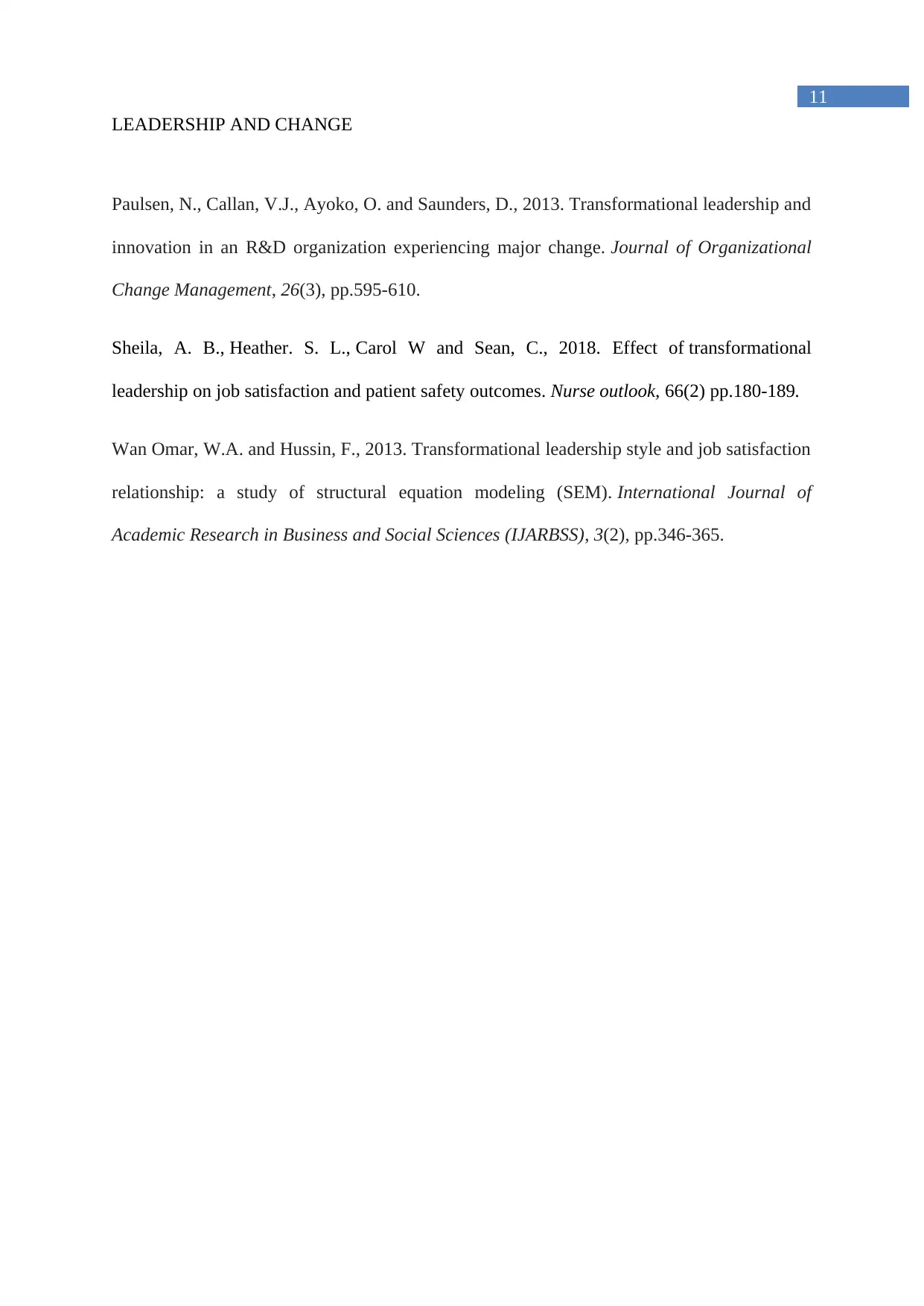
11
LEADERSHIP AND CHANGE
Paulsen, N., Callan, V.J., Ayoko, O. and Saunders, D., 2013. Transformational leadership and
innovation in an R&D organization experiencing major change. Journal of Organizational
Change Management, 26(3), pp.595-610.
Sheila, A. B., Heather. S. L., Carol W and Sean, C., 2018. Effect of transformational
leadership on job satisfaction and patient safety outcomes. Nurse outlook, 66(2) pp.180-189.
Wan Omar, W.A. and Hussin, F., 2013. Transformational leadership style and job satisfaction
relationship: a study of structural equation modeling (SEM). International Journal of
Academic Research in Business and Social Sciences (IJARBSS), 3(2), pp.346-365.
LEADERSHIP AND CHANGE
Paulsen, N., Callan, V.J., Ayoko, O. and Saunders, D., 2013. Transformational leadership and
innovation in an R&D organization experiencing major change. Journal of Organizational
Change Management, 26(3), pp.595-610.
Sheila, A. B., Heather. S. L., Carol W and Sean, C., 2018. Effect of transformational
leadership on job satisfaction and patient safety outcomes. Nurse outlook, 66(2) pp.180-189.
Wan Omar, W.A. and Hussin, F., 2013. Transformational leadership style and job satisfaction
relationship: a study of structural equation modeling (SEM). International Journal of
Academic Research in Business and Social Sciences (IJARBSS), 3(2), pp.346-365.
⊘ This is a preview!⊘
Do you want full access?
Subscribe today to unlock all pages.

Trusted by 1+ million students worldwide
1 out of 12
Related Documents
Your All-in-One AI-Powered Toolkit for Academic Success.
+13062052269
info@desklib.com
Available 24*7 on WhatsApp / Email
![[object Object]](/_next/static/media/star-bottom.7253800d.svg)
Unlock your academic potential
Copyright © 2020–2025 A2Z Services. All Rights Reserved. Developed and managed by ZUCOL.





